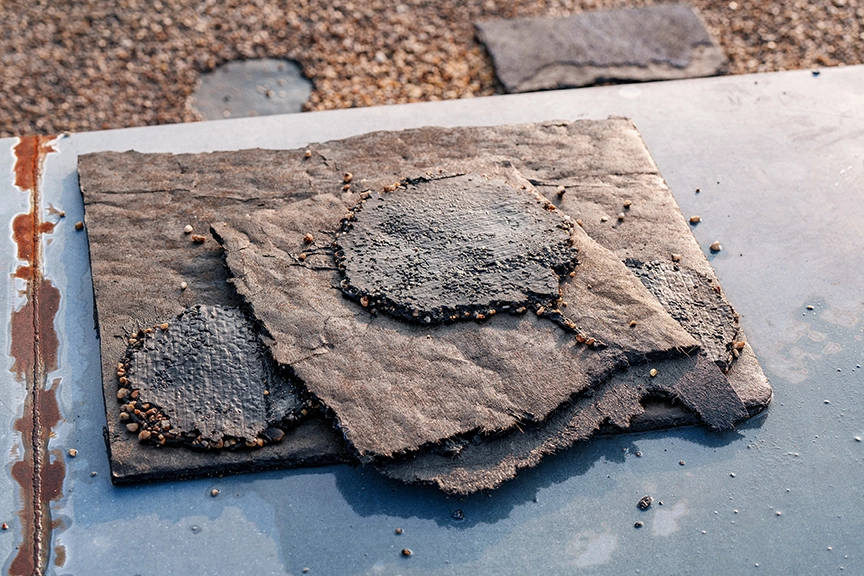Don’t Let High Winds Wreak Havoc on Your Commercial Roof
Last year was a historic year for costly disasters and extreme weather throughout much of the United States. According to the National Oceanic and Atmospheric Administration’s National Centers for Environmental Information, 2023 included 28 weather and climate disasters, surpassing the previous record of 22 in 2020, and costing at least $92.9 billion!

Most of these climate disasters involve severe wind, which can have a very negative impact on any commercial building roof type, particularly if it is not properly designed, installed, or maintained. Key issues caused by severe wind damage include:
Wind Uplift Damage
Strong wind uplift damage occurs when the pressure difference created by wind flow over a roof causes the roofing material to lift or separate from the roof deck or supporting structure. Several different kinds of damage can result.
- The loosening of fasteners, such as nails or screws, which hold roofing materials in place. Once the fasteners are compromised, the roofing materials become more vulnerable to being lifted by the wind, eventually resulting in a compromised roof system.
- The lifting and peeling as intense winds create an upward force on a roof’s surface. If roofing materials are not adequately secured or if the components are old or damaged, wind can lift and peel them away from the roof deck. In addition to blowing roofing material away, lifting and peeling can also expose the underlying roof structure, which can result in additional destruction.
- The roof deck detachment occurs when wind uplift is greater than what the building system was designed for and it detaches from the supporting structure. This is most likely to occur if the roof deck has open joints.
- Damage to the roofing material when severe storms cause shingles, tiles, flashing, or other roofing materials to be torn off or broken by the force of the wind. If not repaired, this type of damage can compromise the integrity of the roof, leading to leaks and further deterioration over time. High winds can also dislodge roof components that support drainage and can lead to pooling water and further damage.
Structural Damage
In addition to wind uplift, another key issue that can occur due to high winds is structural damage. In extreme cases, this results in a partial roof collapse, which is more likely with older or poorly maintained roofs. Fierce winds can also damage the walls and parapets connected to a roof, which could compromise the entire building.
When debris from branches, buildings, and other objects become projectiles due to intense winds, tears and punctures in commercial roofing systems can result. Over time, consistent exposure to high winds can also cause materials to fatigue, leading to additional cracks and tears in the roofing system.
Another type of damage inflicted by severe winds is directly to a roof’s components. This includes the flashing, used to seal edges and joints and can be loosened or torn away, leading to water penetration. When the wind damages the roofing material or the flashing, it can create pathways for water to infiltrate the building, leading to a commercial roof leak, mold, and further damage.
Reduced Energy Efficiency
High winds can cause reduced energy efficiency in a commercial structure as wind can displace or damage insulation layers, reducing a roof’s energy efficiency and increasing a facility’s heating and cooling costs. Roof damage can also lead to thermal bridging, where heat escapes through the damaged areas and affects the building’s energy efficiency.
All these issues create problems which lead to increased maintenance costs. Ongoing wind damage can result in frequent repairs, increasing the overall cost of ownership for a commercial roof. Worse yet, persistent wind damage can significantly shorten the lifespan of a commercial roof, resulting in the need for a commercial roof restoration or complete replacement.
Prevention
Proper commercial roof design, installation, and regular maintenance will help to mitigate the three key issues wind damage can inflict on a commercial roof. If you’re not sure where to begin, start by hiring the right roofing professional to assist you. If you don’t currently work with a roofing company, contact Capital Roof Care. They will set you up with a commercial roof maintenance plan. By conducting regular commercial roof inspections, their maintenance plan will ensure all roofing assets are in good condition and allow for the repair of minor issues before they become a roofing emergency.
No matter what type of commercial roof you have, a roof maintenance plan will ensure your roof is properly designed, constructed, and maintained to withstand expected wind loads, in addition to being able to identify signs of damage that require immediate or future restoration. The wind load calculation for a commercial roof varies depending on where you live, and building codes will mandate specific wind-resistant roofing requirements. A trained roofing technician from Capital Roof Care can recommend wind-resistant roofing materials and appropriate fasteners to ensure your roofing system remains intact.
Don’t let wind damage cost your commercial facility thousands! Be proactive and contact Capital Roof Care today.
Sources: